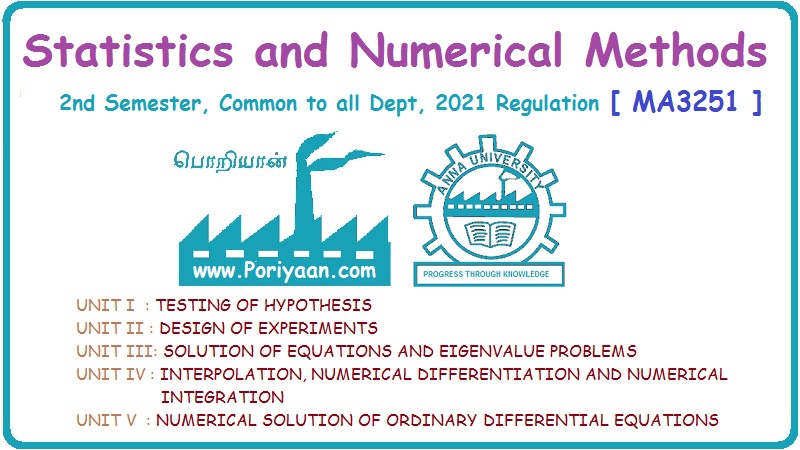Statistics and Numerical Methods: Unit II: Design of Experiments
Latin Square Design
Solved Example Problems | Design of Experiments | Statistics
The term Latin square takes its name from a figure of mathematical puzzle that was studied many years before, use as a plan of experiment.
LATIN SQUARE DESIGN
1. Introduction :
The
term Latin square takes its name from a figure of mathematical puzzle that was
studied many years before, use as a plan of experiment.
Latin
squares are very extensively used in agricultural trials in order to eliminate
fertility trends in two directions, simultaneously. The data are classified
according to the different criteria, (i.e.,) according to columns, rows and
varieties and are arranged in a square known as Latin Square.
Latin
square is one way of reducing the sample size. Suppose, it is desired to study
the results of three different types of teaching methods on students. Suppose,
the effect on students is also affected by their age bracket and by their
aptitude. Our interest is to study the results of the three teaching methods by
blocking the effects of age and aptitude. aloval ponsortingia
Now,
only nine blocks is to be studied in relation to 3 teaching methods, so in the
complete design as many as 27 subjects will have to be studied.
Latin
square design is very popular in agricultural research where it is not possible
to have a large number of subjects.
Latin
squares have an equal number of rows and columns. One blocking factor is
represented in the columns of the other in rows. The factor of interest or
treatment is within each column and row generally represented by alphabets.
Thus, if three teaching methods are to be studied they would be represented by
A, B and C. These alphabets are so arranged that each comes only once in a row
and only once in a column.
Thus,
if three teaching methods A, B and C are to be studied by blocking two factors
age and aptitude the latin square would assume the following shape.

2. Merits and Demerits of Latin Square Design
Merits
1.
Latin Square design controls variability in two directions of the experimental
material.
2.
The analysis of the design is simple and straight forward and is a three way
classification of analysis of variance.
Demerits
1.
The process of randomization is not as simple as in RBD.
2.
The number of treatments should be equal to the number of rows and boliz number
of columns.
3.
The experimental area should be in the form of a square.
4.
It is suitable only in the case of smaller number of treatments (preferably
less than 10).
5.
A 2 × 2 Latin Square is not possible.
3. Assumption in the Analysis of Latin Square
The
Latin Square model assumes that interactions between treatments and row and
column groupings are non-existent. Since, each treatment occurs only once in
each row or column, if interactions are present, it is possible for them to
cause an apparently significant difference between treatments. This is one of
the reasons why it is important to choose rows and columns of a particular
Latin Square in a random way. Interactions present, can be viewed as random
elements that are part of the treatment. They blow up the error variance and
make the test less efficient but their randomization still allows for a valid
theoretical test.
4. Steps in Constructing Latin Square
The
construction of Latin Square involves the following steps:
1.
Compute the correction factor by squaring the grand total and dividing it by
the number of observations.
2.
Compute the total sum of squares by adding the squares of the individual
observations and subtracting the correction factor.
3.
Compute the row sum of squares by adding the squares of the row sums, dividing
by the number of items in a row, and subtracting the correction factor.
4.
Compute the column sum of squares by adding the squares of the column sums,
dividing by the number of items in a column, and subtracting the correction
factor.
5.
Compute the 'treatment' sum of squares by summing the squares of the treatment
sums dividing by the number of treatments, and subtracting the correction
factor.
6.
Compute the remainder sum of squares by subtracting the sum of 3, 4, and 5 from
2.
7.
Enter these sums of squares in an analysis of variance table and compute the
various mean squares.
5. Working Rule
The
analysis is done in a way similar to two-way classification. The different sums
of squares are obtained as follows :
Step
1: Find N.
Step
2: Find T.
Step
3: Find T2 / N.
Step
4: Find TSS
Step
5: Find SSC
Step
6: Find SSR
Step
7: Find SSK
Step
8: Find SSE
Step
9: ANOVA table
Step
10: Conclusion
6. Preparation of ANOVA table
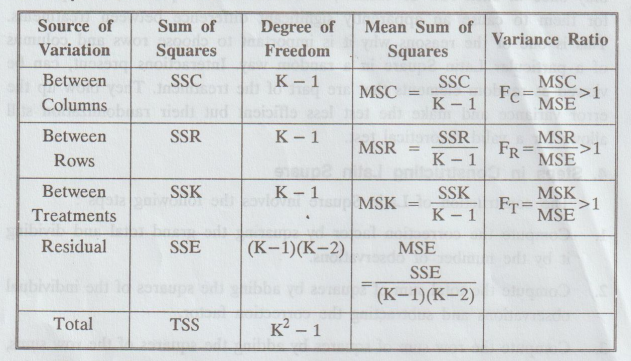
The
F-ratios FC, FR, FT are calculated in a such way that they are each greater
than one.
For
example, if MSC / MSE < 1, then take
Fc = MSE / MSC
Example
2.4.1
The
following is a Latin square of a design, when 4 varieties of seeds are being
tested. Set up the analysis of variance table and state your conclusion. You
may carry out suitable change of origin and scale.
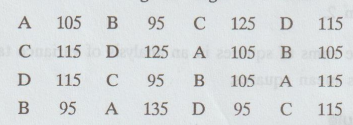
Solution:
Subtract 100 and then divided by 5, we get
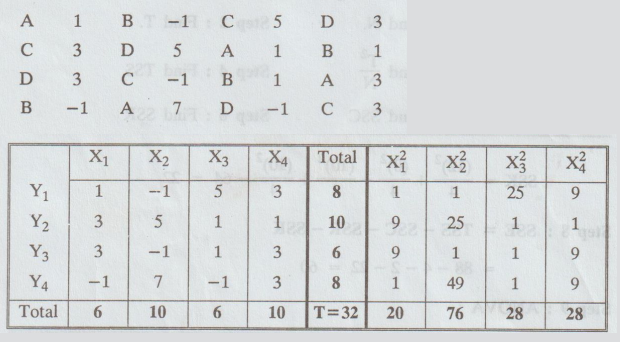
H0
: There is no significant difference between column means, row means and
treatments.
H1
: There is significant difference between column means or the row means
or treatments.
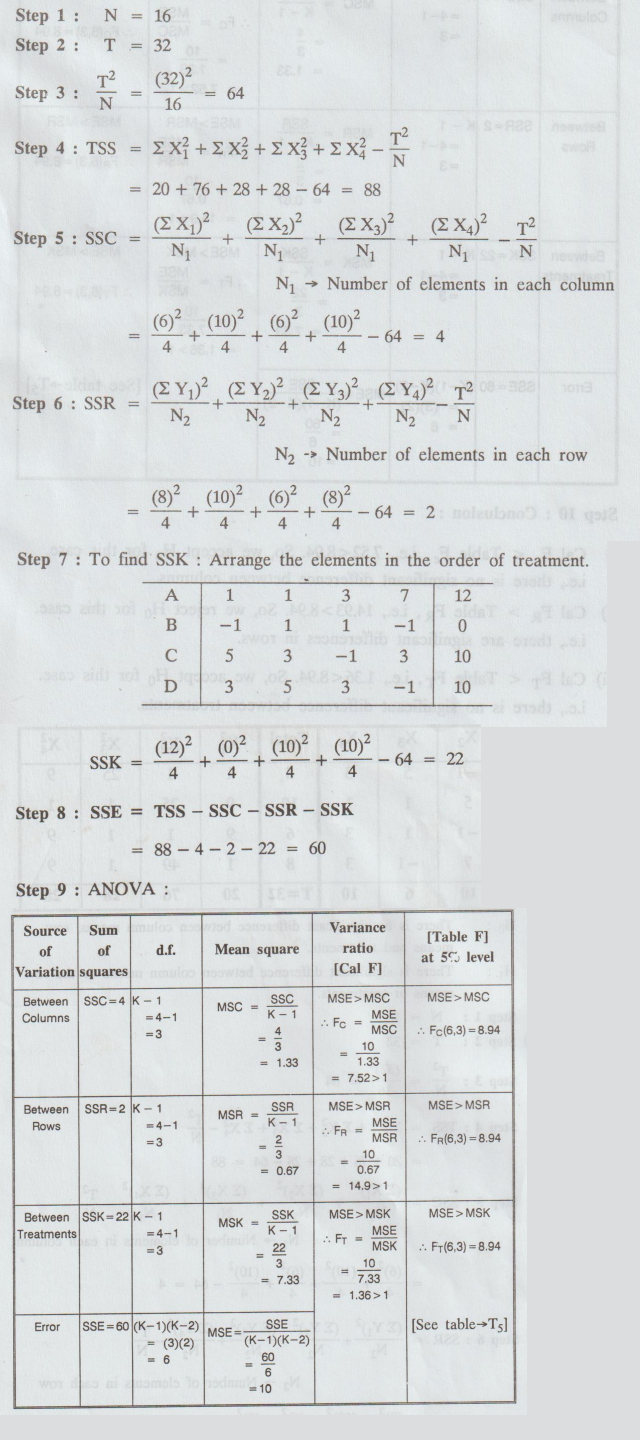
Step
10 Conclusion :
(i)
Cal Fe < Table Fe, i.e., 7.52 < 8.94.
So, we accept Ho for this case.
i.e.,
there is no significant difference between columns.
(ii)
Cal FR > Table FR, i.e., 14.93 > 8.94. So, we reject Ho for this case.
i.e.,
there are significant differences in rows.
(iii)
Cal FT< Table FT, i.e., 1.36<8.94. So, we accept Ho for this case.
i.e.,
there is no significant difference between treatments.
Example
2.4.2
A
variable trial was conducted on wheat with 4 varieties in a Latin Square Design.
The plan of the experiment and the per plot yield are given below:
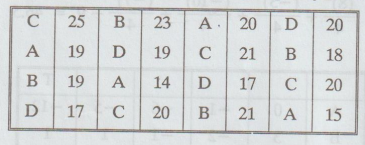
Analyse
data and interpret the result. [A.U M/J 2012]
[A.U
N/D 2016 R-13] [A.U A/M 2017 R-13] [A.U N/D 2019 R-13]
Solution:
Subtract 20 from all the items.

H0
: There is no significant difference between rows, columns and
treatments.
H1
: There is significant difference between rows or columns or treatments.

Step
10 Conclusion :
(i)
Cal Fe < Table Fe, i.e., 1.43 < 4.76. So, we accept Ho for this case.
i.e.,
there is no significant difference between columns.
(ii)
Cal FR > Table FR, i.e., 8.86 > 4.76. So, we reject Ho for this case.
i.e.,
there are significant differences in rows.
(iii)
Cal FT > Table Fr, i.e., 9.24>4.76. So, we reject Ho for this case.
i.e., there are significant difference in
treatments.
Example
2.4.3
A
farmer wishes to test the effects of four different fertilizers A, B, C, D on
the yield of wheat. In order to eliminate sources of error due to variability
in soil fertility, he uses the fertilizers, in a Latin square arrangement as
indicated in the following table, where the numbers indicate yields in bushels
per unit area.
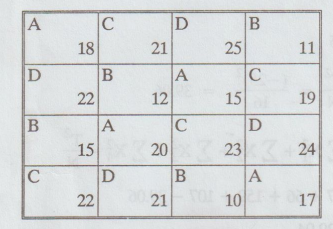
Perform
an analysis of variance to determine, if there is a significant difference
between the fertilizers at a = 0.05 level of significance. [A.U. M/J 2007]
[Tvli M/J 2009] [A.U N/D 2012] [A.U A/M 2019 R-17] [A.U N.D 2020 R-17]
Solution
:
Subtract
20 we get
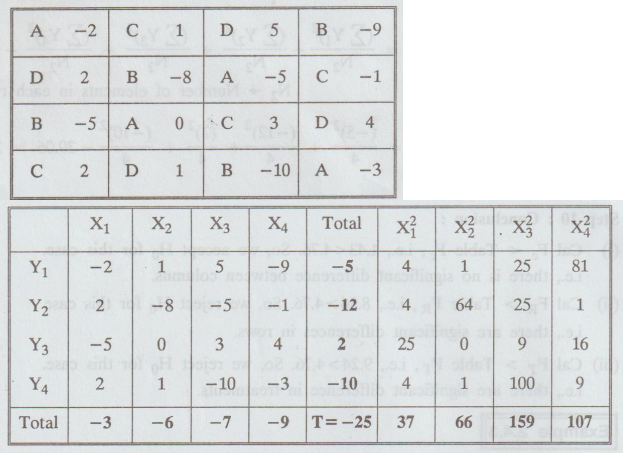
H0
: There is no significant difference between rows, columns and
treatments.
H1
: There is significant difference between rows or columns or treatments.
Step
1: N = 16
Step
2: T = -25
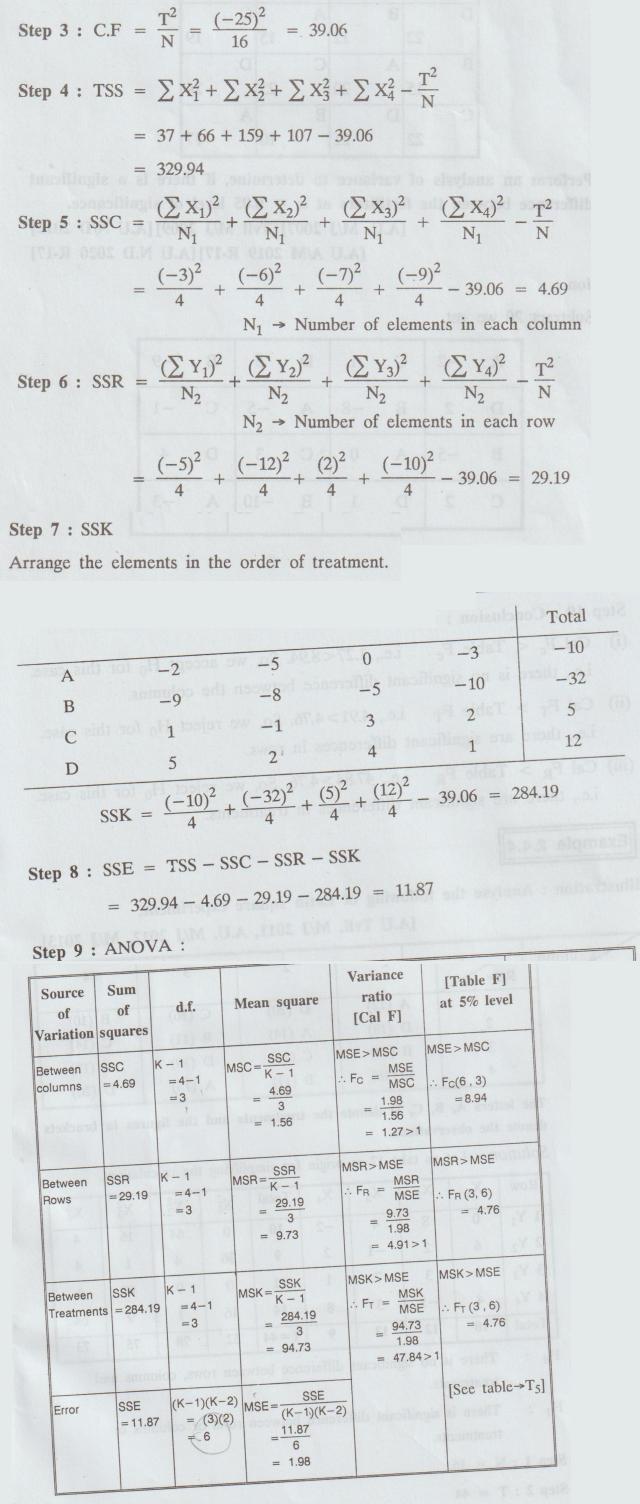
Step
10 : Conclusion :
(i)
Cal Fe < Table Fe i.e., 1.27 < 8.94. So, we accept Ho for this case.
i.e.,
there is no significant difference between the columns.
(ii) Cal FT > Table FT
i.e., 4.91 > 4.76. So, we reject Ho for this case.
i.e.,
there are significant differences in rows.
(iii)
Cal FR > Table FR i.e., 47.84>4.76. So, we reject
Ho for this case. i.e., there are significant differences in treatments.
Example
2.4.4
Illustration:
Analyse the following of Latin square experiment. [A.U Tvli. M/J 2011, A.U. M/J
2012, M/J 2013]

The
letters A, B, C, D denote the treatments and the figures in brackets denote the
observations.
Solution:
Let us take 12 as origin for simplifying the calculations.
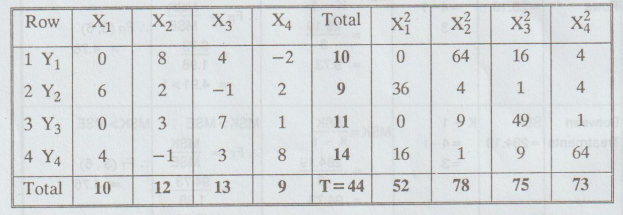
H0
: There is no significant difference between rows, columns and treatments.
H1
: There is significant difference between rows or columns or treatments.
Step
1: N = 16
Step
2: T = 44
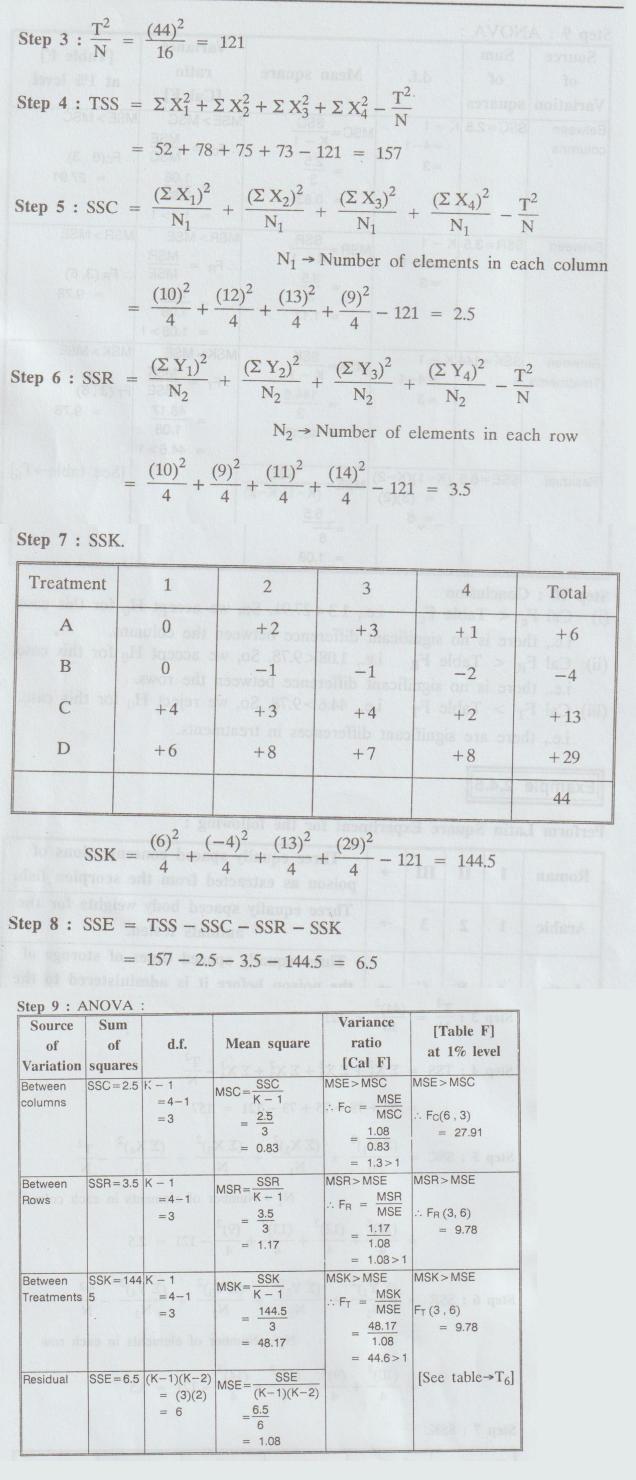
Step
10: Conclusion :
(i)
Cal Fe < Table Fe i.e., 1.3 <
27.91. So, we accept H0 for this case.
i.e.,
there is no significant difference between the columns.
(ii)
Cal FR < Table FR i.e., 1.08 < 9.78. So, we accept
H0 for this case.
i.e.,
there is no significant difference between the rows.
(iii)
Cal FT > Table FT i.e., 44.6 > 9.78. So, we reject
H0 for this case.
i.e.,
there are significant differences in treatments.
Example
2.4.5
Perform
Latin Square Experiment for the following:
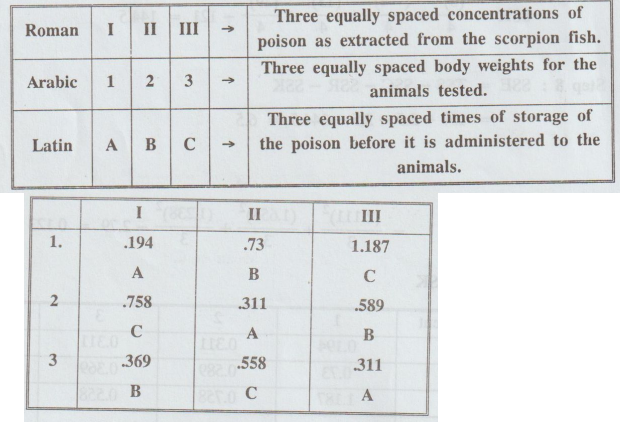
Solution
:

H0
: There is no significant difference between rows, columns and treatments.
H1
: There is significant difference between rows or columns or treatments.
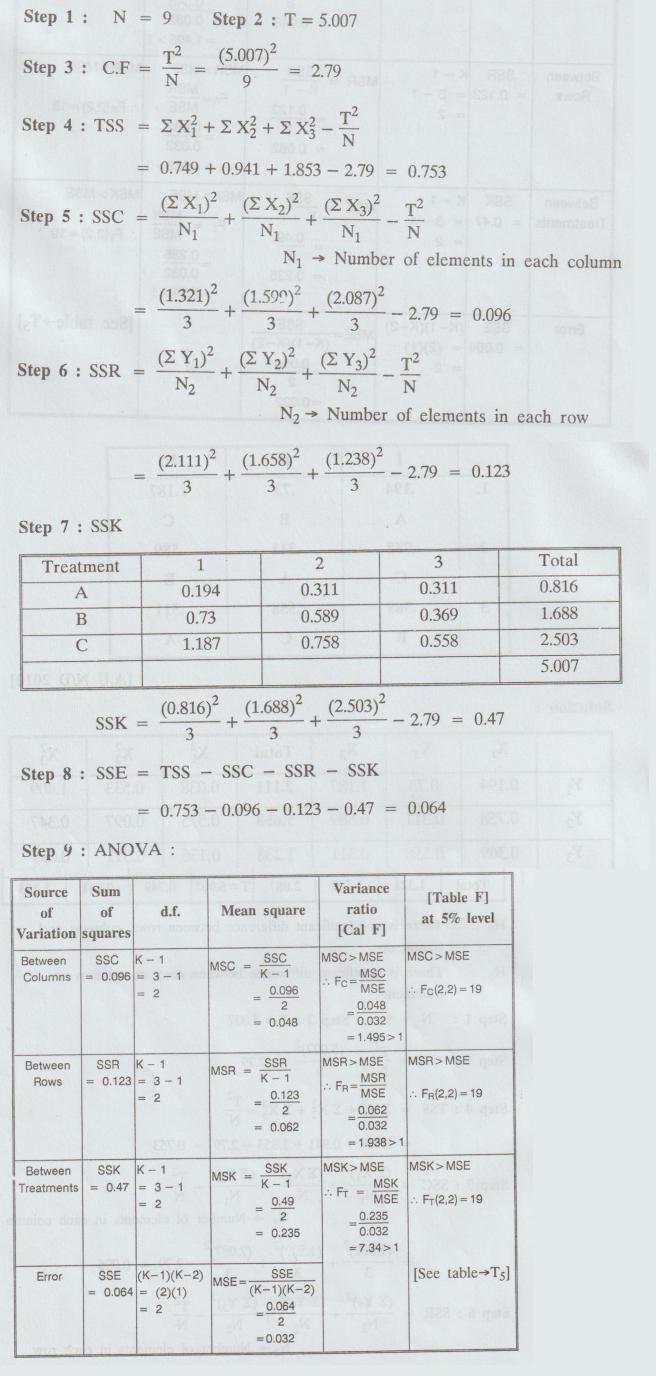
Step
10 : Conclusion:
(i)
Cal Fe < Table Fe, i.e., 1.495 < 19. So, we accept H0 for this
case.
i.e.,
there is no significant difference in columns.
(ii)
Cal FR Table FR, i.e., 1.938 < 19. So, we accept H0
for this case.
i.e.,
there is no significant difference in rows.
(iii)
Cal FT < Table FT, i.e., 7.34 < 19. So, we accept
Ho for this case.
i.e.,
there is no significant difference in treatments.
Example
2.4.6
In
a Latin square experiment given below are the yields in quintals per acre on
the paddy crop carried out for testing the effect of five fertilizers A, B, C,
D, E. Analyze the data for variations.
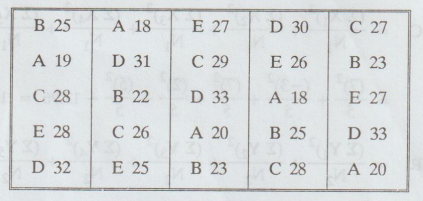
Solution
:
It
is a 5 × 5 Latin square. Let us subtract 25 from all the items.
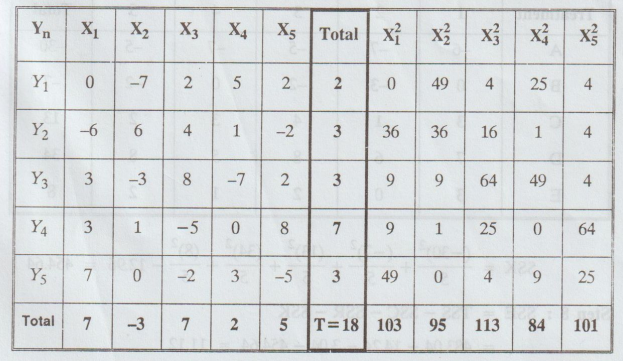
H0
: There is no significant difference between rows, columns and treatments.
H1
: There is significant difference between rows or columns or treatments.
Step
1: N = 25
Step
2: T = 18

Step
10 Conclusion :
(i)
Cal Fe Table Fe, i.e., 3.84 > 3.26. So, we reject H0 for this
case.
i.e.,
there are significant differences in columns.
(ii)
Cal FR < Table FR, i.e.,1.22 < 5.91. So, we accept
H0 for this case.
i.e.,
there is no significant difference between rows.
(iii) Cal FT > Table FT,
i.e., 122.61 > 3.26. So, we reject Ho for this case.
i.e.,
there are significant differences in treatments.
Example
2.4.7
Analyze
the data given below and interpret the results.
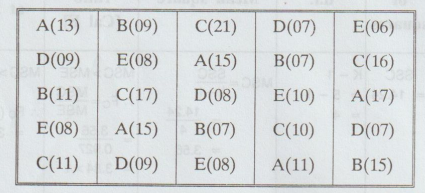
Solution
Subtract
10 from the given data
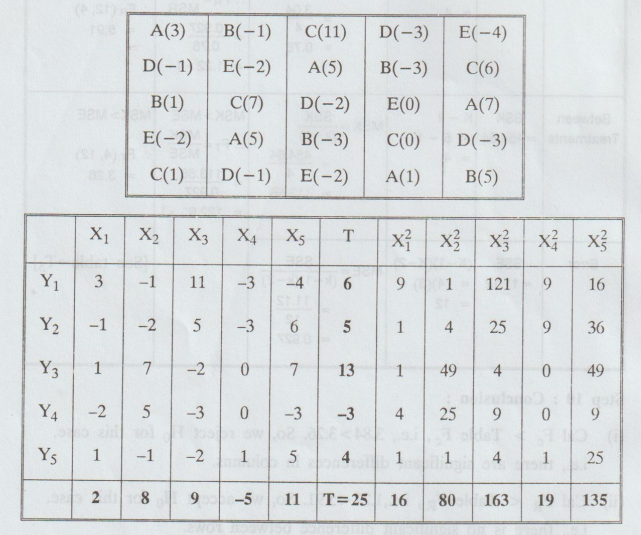
H0
: There is no significant difference between column means, row means and
treatments.
H1
: There is significant difference between column means or the row means
or treatments.
Step
1: N = 25
Step
2: T = 25
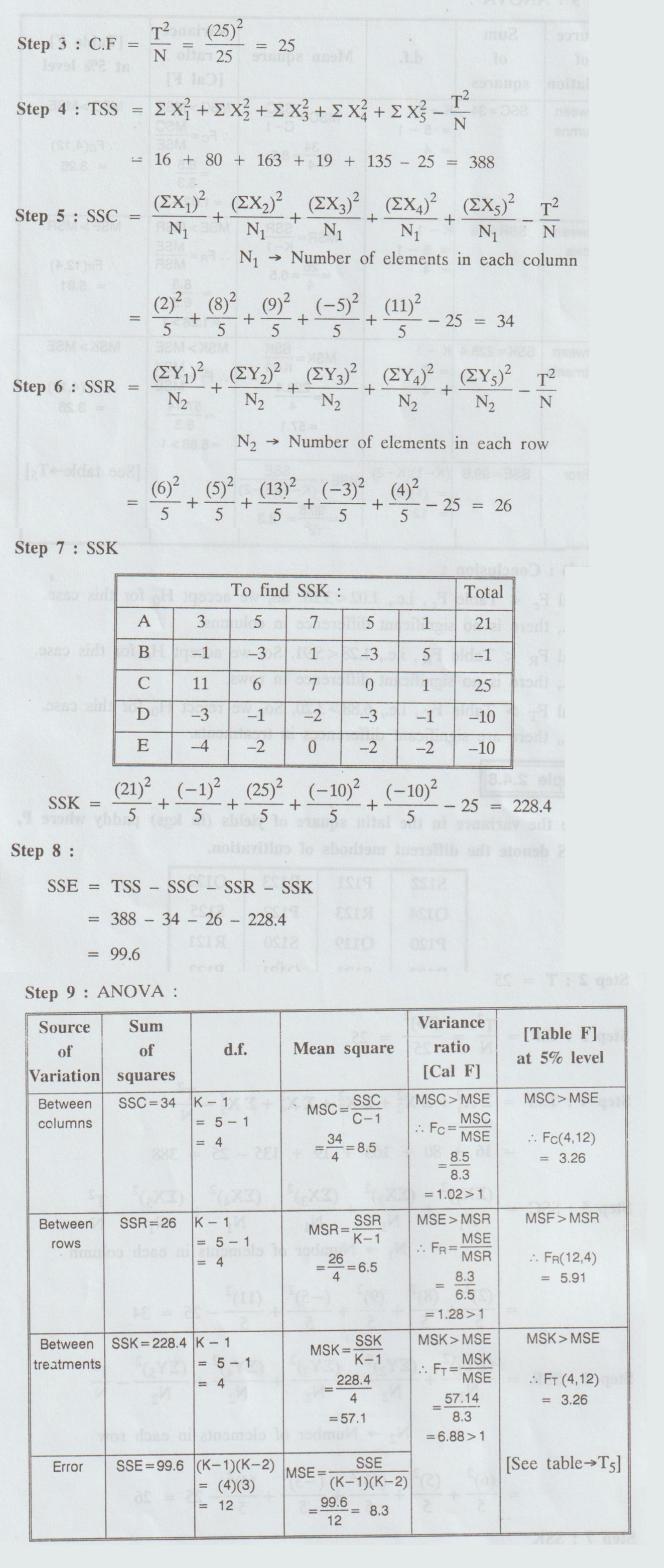
Step
10 Conclusion :
(i)
Cal Fe < Table Fe, i.e., 1.02 < 3.26. So, we accept Ho for this case.
i.e.,
there is no significant difference in columns.
(ii)
Cal FR < Table FR, i.e., 1.28 < 5.91. So, we accept
Ho for this case.
i.e.,
there is no significant difference in rows.
(iii)
Cal FT > Table FT, i.e., 6.88 > 3.20. So, we reject
Ho for this case. i.e., there are significant differences in treatments.
Example
2.4.8
Analyze
the variance in the latin square of yields (in kgs) paddy where P, Q, R, S
denote the different methods of cultivation.
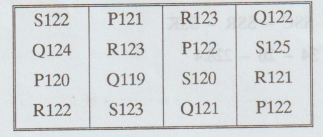
Examine
whether the different methods of cultivation have given significantly different
yields.so lo Tobro odini atasmala adi sgantA [A.U. N/D 2003, M/J 2006, N/D
2012] [A.U N/D 2019 R-17]
Solution
.
Subtract 120 weget
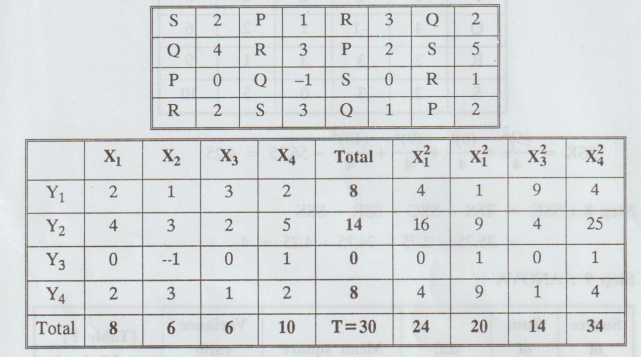
H0
: There is no significant difference between rows, columns and treatments.
H1
: There is significant difference between rows or columns or treatments.
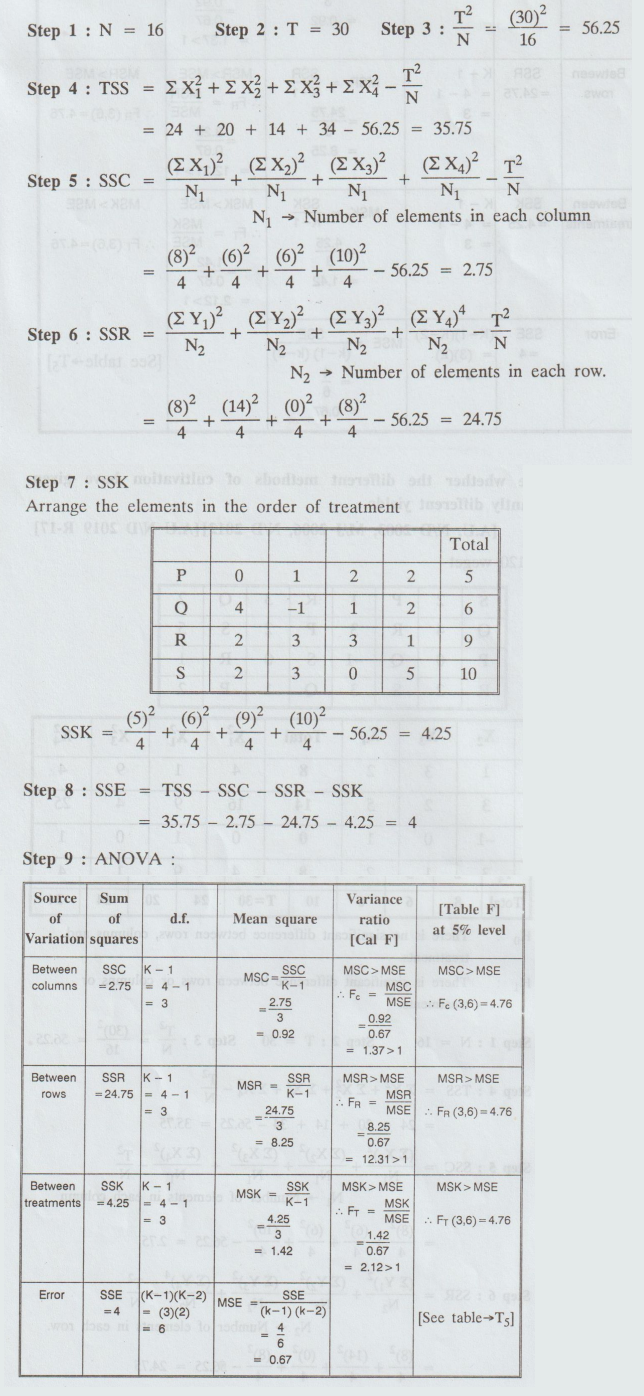
Step
10 Conclusion :
(i)
Cal Fe < Table Fc, i.e., 1.37 < 4.76. So, we accept Ho for this case.
i.e.,
there is no significant difference in columns.
(ii)
Cal FR > Table FR, i.e., 12.31 >4.76. So, we reject
Ho for this case.
i.e.,
there are significant differences in rows.
(iii)
Cal FT < Table FT, i.e., 2.12 < 4.76. So, we accept
Ho for this case.
i.e.,
there is no significant difference in treatments.
Example
2.4.9
The
following data resulted from an experiment to compare 3 burners B1, B2, B3. A
Latin square design was used as the tests were made on 3 engines and were
spread over 3 days. Perform an analysis of variance at 5% level of significance
on the data.
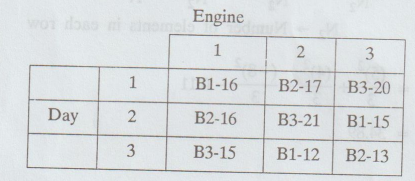
Solution
:
H0
: There is no significant difference between rows, columns and treatments.
H1
: There is significant difference between rows or columns or treatments.
Subtract
16 from each figure
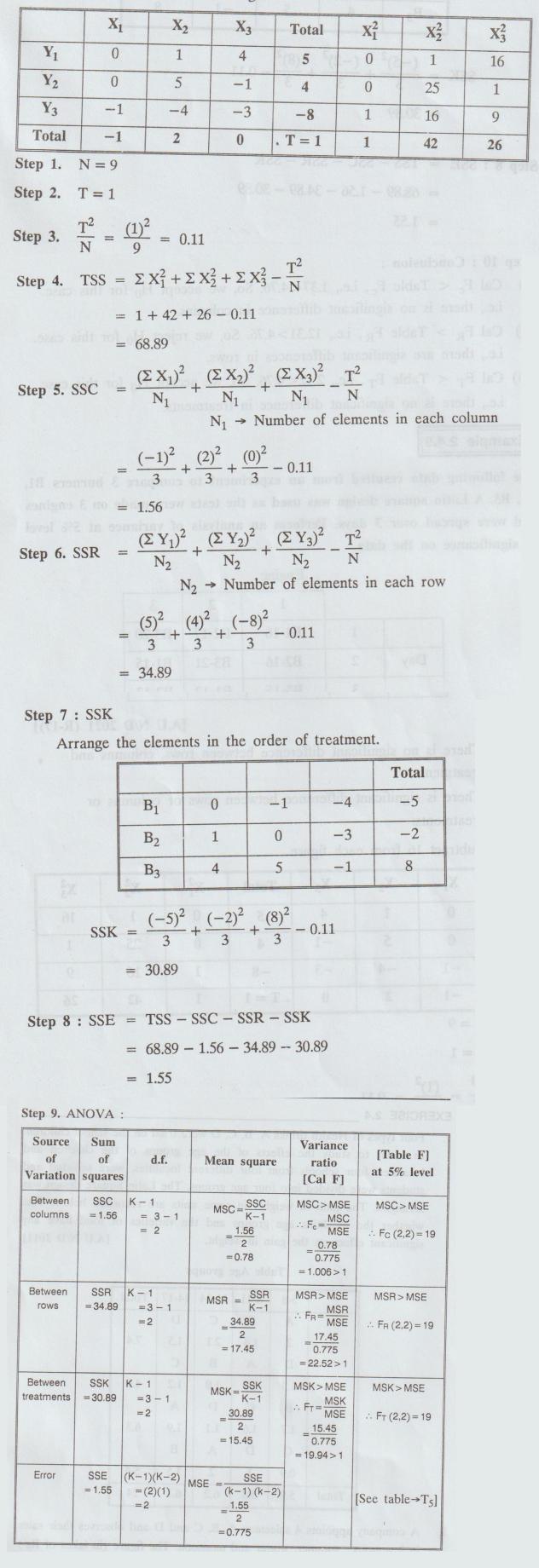
Step
10 Conclusion :
(i)
Here, Cal Fc < table Fe i.e., 1.006 < 19
So,
we accept H0 for this case.
i.e.,
there is no significant difference between columns.
(ii)
Here, Cal FR > table FR i.e., 22.52 > 19
So,
we reject Ho for this case.
i.e.,
there are significant differences in rows.
(iii)
Here, Cal FT > table FT i.e., 19.94 > 19
So,
we reject Ho for this case.
i.e.,
there are significant differences in treatments.
Statistics and Numerical Methods: Unit II: Design of Experiments : Tag: : Solved Example Problems | Design of Experiments | Statistics - Latin Square Design
Related Topics
Related Subjects
Statistics and Numerical Methods
MA3251 2nd Semester 2021 Regulation M2 Engineering Mathematics 2 | 2nd Semester Common to all Dept 2021 Regulation
